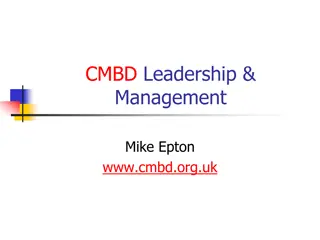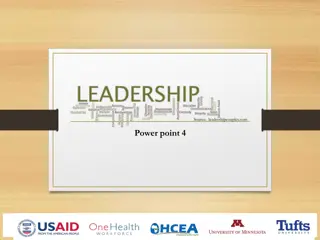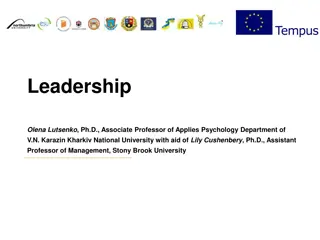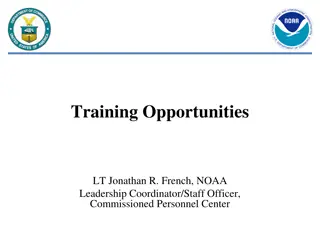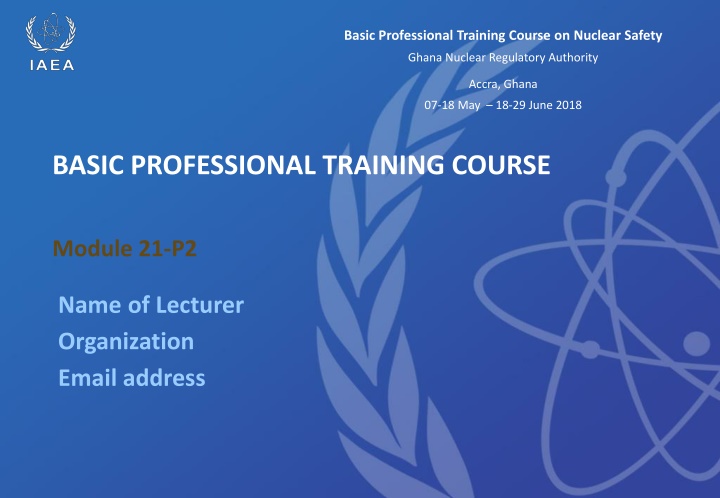
Professional Training Course on Nuclear Safety and Leadership
"Explore a comprehensive training course on nuclear safety and leadership conducted by the Ghana Nuclear Regulatory Authority. Gain insights into IAEA safety standards, leadership roles, and responsibilities, with a focus on effective leadership principles for maintaining safety in nuclear facilities."
Download Presentation

Please find below an Image/Link to download the presentation.
The content on the website is provided AS IS for your information and personal use only. It may not be sold, licensed, or shared on other websites without obtaining consent from the author. If you encounter any issues during the download, it is possible that the publisher has removed the file from their server.
You are allowed to download the files provided on this website for personal or commercial use, subject to the condition that they are used lawfully. All files are the property of their respective owners.
The content on the website is provided AS IS for your information and personal use only. It may not be sold, licensed, or shared on other websites without obtaining consent from the author.
E N D
Presentation Transcript
Basic Professional Training Course on Nuclear Safety Ghana Nuclear Regulatory Authority Accra, Ghana 07-18 May 18-29 June 2018 BASIC PROFESSIONAL TRAINING COURSE Module 21-P2 Name of Lecturer Organization Email address
Basic Professional Training Course on Nuclear Safety Ghana Nuclear Regulatory Authority Accra, Ghana 07-18 May 18-29 June 2018 BASIC PROFESSIONAL TRAINING COURSE Leadership, Management for Safety and Safety Culture Leadership for Safety This material was prepared by the IAEA and co-funded by the European Union.
Contents SF GSGs 1. IAEA Approach SSRs GSGs 2. Concept of Leadership for Safety SSG 3. Leadership Roles and Responsibilities 4. Vision for managing growth of and change in the organization 3 07-18 May - 18-29 June 2018 Leadership and Management for Safety
Learning objectives Leadership for Safety After completing this chapter from Module 21, the trainee will be able to understand: 1. IAEA safety standards relevant to Leadership for Safety requirements 2. Basic concept of Leadership and management 3. Leadership responsibilities 4. Leadership vision for managing growth of and change in the organization 4 07-18 May - 18-29 June 2018 Leadership and Management for Safety
IAEA Approach 07-18 May - 18-29 June 2018
Fundamental Safety Principles Principle 3: Effective leadership and management for safety must be established and sustained in organizations concerned with, and facilities and activities that give rise to, radiation risks. Leadership in safety matters has to be demonstrated at the highest levels in an organization as well as demonstrated at all other levels in the organization Leadership aims at achieving commitment to goals, shared values and behaviours that influences and motivates individuals and organizations to continually improve performance. A Leader influences on the thoughts, attitudes and behaviour of others Leaders take responsibility for their actions and hold others responsible for theirs. 6 07-18 May - 18-29 June 2018 Leadership and Management for Safety
Fundamental Safety Principles Lesson-learned from Fukushima (SF-1) Prime responsibility for safety rests with Licensee. However, at an international level, all eyes looked to the regulatory body for answers on how this could have happened Regulatory body mandate and accountability is to regulate safety for achieving fundamental safety objective Keys to meeting this challenge as a regulatory body: Ensure that the legal and regulatory framework is in place Maintain high degree of confidence by ensuring safety Use a systemic approach Safety is the result of interaction between Individual, Technology and Organization (ITO) Need for effective Leadership, safety culture and management system to ensure proper management for safety 7 07-18 May - 18-29 June 2018 Leadership and Management for Safety
GSR Part 2 Leadership & Management for Safety Responsibility for Integration of Safety into the Management System R1: Achieving the fundamental safety objective Responsibility for Safety Culture for Safety Leadership for Safety R12: Fostering a culture for safety R2: Demonstration leadership for safety by managers R3: Responsibility of Senior Management for the Management System R13: Measurement, assessment and improvement of the management system Measurement, Assessment and Improvement Management for Safety R4: Goals, strategies, plans and objectives R14: Measurement, assessment and improvement of the management system R5: Interaction with interested parties Management of Processes and Activities The Management System R6: Integration of the Management System R7: Application of the Graded Approach R8: Documentation of the Management System Management of Resources R9: Provision of Resources R10: Management of Processes and Activities R11: Management of the Supply Chain Management of Processes and Activities 07-18 May - 18-29 June 2018 8 Leadership and Management for Safety
GSR Part 2: Leadership for Safety Req. 1: Achieving the Fundamental Safety Objective Achieving the fundamental safety objective Leadership for Safety Effective management for safety Proper consideration of ITO Measurement, Assessment and Improvement Responsibility of Management Process Implementation Management of Resources Safety Culture Leadership for safety and management for safety are to be developed together and integrated so that all individuals in an organization are involved and are committed to safety and regulatory performance 9 07-18 May - 18-29 June 2018 Leadership and Management for Safety
GSR Part 2: Leadership for Safety Requirement 2: Demonstration of leadership for safety by managers Managers shall demonstrate leadership for safety and commitment to safety 3.1. The senior management of the organization shall demonstrate leadership for safety by: (a) Establishing, advocating and adhering to an organizational approach to safety - as an overriding priority . (b) Acknowledging interactions between people, technology and the organization (ITO) (c) Fostering a strong safety culture (d) Establishing responsibilities and accountability for safety for all individuals in the organization and establishing that decisions taken consider safety as priority 10 07-18 May - 18-29 June 2018 Leadership and Management for Safety
GSR Part 2: Leadership for Safety 3.2. Managers at all levels in the organization, taking into account their duties, shall ensure that their leadership includes: (a) Setting goals for safety consistent with safety policy (b) Setting responsibilities and authorities of all individuals at all levels (c) Demonstrating commitment to improving safety performance (d) Development of individual and institutional values and acting as role models; (e) Develop questioning and learning attitudes 3.3. Managers at all levels in the organization shall: (a) Encourage and support individuals in achieving safety goals and performing their tasks safely (b) Engage all individuals in enhancing safety performance (c) Communicate clearly the basis for safety related decisions 11 07-18 May - 18-29 June 2018 Leadership and Management for Safety
Safety Culture characteristics and attributes 1. Commitment to safety by senior management 2. Commitment to safety is evident at all management levels 3. Visible leadership showing involvement of management in safety related activities 4. Leadership skills are systematically developed 5. Management assures that there is sufficient and competent staff 6. Management seeks the active involvement of staff in improving safety 7. Safety implications are considered in the change management process 8. Management shows a continuous effort to strive for openness and good communications throughout the organization 9. Management has the ability to resolve conflicts as necessary 10.Relationships between management and staff are built on trust General Safety Guide GS-G-3.1 12 07-18 May - 18-29 June 2018 Leadership and Management for Safety
SSG-16: Leadership for safety SSG-16 Actions 72-84 provide recommendations for building of leadership and management for safety and of a safety culture amongst the involved organisations in nuclear power programme Ready to make a knowledgeable commitment to a nuclear programme Ready to invite bids Ready to commission and operate the first NPP Phase 1 Role of the Government Phase 2 Phase 3 Action 72, 74 Implementation of the Regulatory Body Action 78, 82 Action 75, 76 Implementation of the Operating Organization Action 78, 82 Action 75, 76 M1 M2 M3 13 13 07-18 May - 18-29 June 2018 Leadership and Management for Safety
Concept of Leadership for Safety 07-18 May - 18-29 June 2018
Definitions of Leadership Leadership is the process of creating clarity and consistency of direction and making that direction important, exciting, and worthy to others. ~ Lawrence M. Miller, USA Leadership is not simply a process of acting or behaving, or a process of manipulating rewards. It is a process of power-based reality construction and needs to be understood in these terms. ~ Mats Alvesson, Sweden 15 07-18 May - 18-29 June 2018 Leadership and Management for Safety
Difference between management and leadership management is a function and leadership is a relation. Management ensures that work is completed in accordance with requirements, plan and resources. It is through leadership that individuals may be influenced and motivated, and organizations changed. Managers may also act as leaders. Management is a formal, authorized function for ensuring that an organization operates efficiently and that work is completed in accordance with requirements, plans and resources. Leadership is the use of one s capabilities and competences to give direction to individuals and groups and to influence their commitment to achieving the fundamental safety objective by means of shared goals, values and behaviour Managers at all levels need to be leaders for safety 16 07-18 May - 18-29 June 2018 Leadership and Management for Safety
Difference between management and leadership To manage means to accomplish activities and master routines, while to lead means to influence others and create shared understanding as driver for change Good Managers act as leaders Leaders are not necessarily managers Leadership = a relationship Create shared understanding as driver for change Define and share current and expected situations Aligning people Motivating, influencing and inspiring Management = a function Focus on short-term objectives and goals achievement Planning, Budgeting, Organizing, Staffing Task distribution and follow-up Controlling, problem Solving Leading Managing SAFETY 17 07-18 May - 18-29 June 2018 Leadership and Management for Safety
Roles and Responsibilities 07-18 May - 18-29 June 2018
Leadership Roles and Responsibilities The Leader s Role: 1. Define reality: Where are we today? Plan to move forward.. 2. Define the vision: Where do we want to be? Vision and Mission 3. Define how we will get there? Strategies for directions and Goals to achieve objective So how can leaders influence culture for safety? Leadership is not simply a process of acting or behaving, or a process of manipulating rewards. It is a process of power-based reality construction and needs to be understood in these terms. To answer we need to understand what drives human behaviour on an individual and collective level Leaders must know what characteristics and attributes they want to see in the workplace, and what they want to achieve 19 07-18 May - 18-29 June 2018 Leadership and Management for Safety
Leadership Roles and Responsibilities Leadership aims at achieving commitment to goals, shared values and behaviours that influences and motivates individuals and organizations to continually improve performance A clear policy, vision, strategy, plans and objectives should be developed and communicated frequently and consistently. Should develop a good understanding, and communicate the beliefs that underlie the organization s policies through their own behaviour and management practices. Leaders at all levels in the regulatory body show commitment to continuous improvement Leaders will acknowledge that safety encompasses interactions between individuals, technology and the organizations ITO The interaction between Individuals, Technology and Organization 20 07-18 May - 18-29 June 2018 Leadership and Management for Safety
Leadership Roles and Responsibilities How do you feel about accountability for regulating safety? Are you aware about how your regulatory body could be affected by the national energy policy? What is regulatory body s mandate? Where does the regulatory body fit in the national legal system? Who is accountable for national nuclear safety? How are you making this happen in your country? What do you need to do next? Clearly understand your role and functions Develop organizational configuration Clearly articulate goals and objectives Ensure the development of the management system Foster a strong safety culture GSR Part 2 | Requirement 2 21 07-18 May - 18-29 June 2018 Leadership and Management for Safety
Organizational Role How is the organization structured? How it is resourced? How commitment to safety is realized? How organizational culture that supports and encourages trust, collaboration, consultation and communication is influenced? How national and international interfaces are managed? [GSR Part 1, Req.12] How is your organization integrated with the global nuclear safety regime? How organizational growth and change is managed? [SSG 16 | Action. 76] Key aspects of a good leader Set an example as role model Provide direction, clear goals, communicate motivate, mobilise, cultivate, empower mentor, coach, foster involvement instil trust and loyalty Recognise and reward performance Adapt to leadership style to the demands of the situation, it takes time and leadership to put a management system in place 22 07-18 May - 18-29 June 2018 Leadership and Management for Safety
Vision for managing growth of and change in the organization 07-18 May - 18-29 June 2018
Managing Growth of and Change in the Organization Phase 2: Action 76. The regulatory body should develop competences in managing the growth of and change in the organization 1. Identify the reason for growth of and change in the organization To be able to regulate safety of the nuclear power plant 2. Change Management Policy Describe the philosophy, principles and fundamental factors to guide action and decision-making and give priority to safety Align action with vision, mission, values, goals, and strategy Ensure internal and external communication 3. How to manage the growth of and change in the organization Determine needs then objectives Establish your strategy Take stock on the current situation and identify the gaps Formulate and implement plans Monitor, review and improve to ensure proper management of the change and growth 24 07-18 May - 18-29 June 2018 Leadership and Management for Safety
Managing Growth of and Change in the Organization Process Flowchart Feedback Forces Initiating Growth/Change Determinants Organizational initiator Change Agent What is to be Changed? Intervention strategies Structure? Organizational Processes? Culture? Change Process Implementing Tactics Implementation Intervention Participation Persuasion Change Unlock change relock Growth/Change Results Organizational Effectiveness Ref: NGT 1.1 Leadership and Management for Safety 25 07-18 May - 18-29 June 2018
Leadership for Safety - Continuous Improvement Measurement, Assessment and Improvement Requirement 14: Measurement, assessment and improvement of leadership for safety and of safety culture Senior management shall regularly commission assessments of leadership for safety and of safety culture in its own organization Senior management shall ensure that self-assessment and independent assessment of leadership for safety be conducted at all organizational levels and for all functions using recognized experts The results of self-assessments and independent assessments of leadership for safety shall be communicated at all levels in the organization. The results of such assessments shall be acted upon to improve leadership for safety and to foster a learning attitude within the organization. 26 07-18 May - 18-29 June 2018 Leadership and Management for Safety
Summary Leadership for safety and management for safety are to be developed together and integrated so that all individuals in an organization are involved and are committed to safety and performance A leader has capabilities and competences to give direction to individuals and to influence their commitment to achieving the fundamental safety objective by means of shared goals, values and behavior Leadership provides vision for managing growth of and change in the organization Senior management shall regularly perform assessments of leadership for safety and the results shall be communicated at all levels in the organization 27 07-18 May - 18-29 June 2018 Leadership and Management for Safety
Key Points Leadership in safety matters has to be demonstrated at the highest levels in an organization . Difference between management and leadership states management is a function and leadership is a relation. To manage means to accomplish activities and master routines, while to lead means to influence others and create shared understanding as driver for change. Leaders take responsibility for their actions and hold others responsible for theirs. Making major organisational growth and change requires a clear leadership competences for an effective and efficient project management 28 07-18 May - 18-29 June 2018 Leadership and Management for Safety
Questions 10-15 minutes discussion 1. What is the basic difference between leadership and management? 2. Outline difference and correlations between management and leadership? 3. What are the main leadership responsibilities ? 4. Lists some of the characteristics of leadership that improve performance. 29 07-18 May - 18-29 June 2018 Leadership and Management for Safety
List of abbreviations IMS- Integrated Management System INSAG International Nuclear Safety Advisory Group GSR General Safety Requirement GSG General Safety Guide SSG Specific Safety Guide 30 07-18 May - 18-29 June 2018 Leadership and Management for Safety
References INTERNATIONAL ATOMIC ENERGY AGENCY, Fundamental Safety Principles, Safety Standards Series No. SF-1, IAEA, Vienna (2006). INTERNATIONAL ATOMIC ENERGY AGENCY, Governmental, Legal and Regulatory Framework for Safety, IAEA Safety Standards Series No. GSR Part 1 (Rev. 1), IAEA, Vienna (2016). INTERNATIONAL ATOMIC ENERGY AGENCY, Safety Requirements No. GSR Part 2, Leadership and Management for Safety (2016). INTERNATIONAL ATOMIC ENERGY AGENCY, Application of the Management System for Facilities and Activities, Safety Guide No. GS-G-3.1, IAEA, Vienna (2006). INTERNATIONAL ATOMIC ENERGY AGENCY, The Management System for Nuclear Installations, Safety Guide No. GS-G-3.5, IAEA, Vienna (2009). 31 07-18 May - 18-29 June 2018 Leadership and Management for Safety
Basic Professional Training Course on Nuclear Safety Ghana Nuclear Regulatory Authority Accra, Ghana 07-18 May 18-29 June 2018 Related image Thank you!














